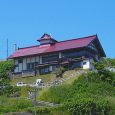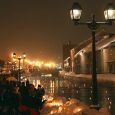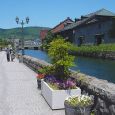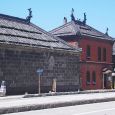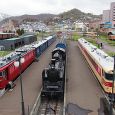Otaru
Advertisement
By train
Otaru is a major station on the JR Hakodate Line from Sapporo, with very frequent train runs. At a cost of ¥620, there are at least five trains per hour; the fastest service, the Airport Rapid, reaches Otaru in 30 minutes. The complete journey on the Airport Rapid from New Chitose Airport to Otaru takes 70 minutes.
By car
Otaru is 25 minutes away from Sapporo by car.
By ferry
Otaru is one of Hokkaido's key ferry ports, and the closest to Sapporo. Shin-Nihonkai Ferry operates a daily service between Otaru and Niigata (18 hours, ¥6,200+) and between Otaru and Maizuru near Kyoto (20 hours, ¥9,600+). Both services are overnight, and private cabins are available for a higher fare .
Otaru Canal
Otaru Canal was a central part of the city's busy port in the first half of the 20th century. Large vessels were unloaded by smaller ships, which then transported the goods to warehouses along the canal.
The canal became obsolete when modern dock facilities allowed for direct unloading of larger vessels. Thanks to a citizens' movement, a part of the canal was beautifully restored in the 1980s instead of being landfilled, while the warehouses were transformed into museums, shops and restaurants.
The canal makes for a pleasant stroll during the day, when artists present their works to passing tourists, and during the evenings when old fashioned gas lamps are lit and provide a romantic atmosphere. The canal also serves as the main site of the town's Snow Light Path Festival.
Herring Mansions (Nishin Goten)
The herring fishing industry played a major role in the history of Otaru since the early days of the town's development, with the vast majority of fish being processed into fertilizer rather than consumed by humans. Large fortunes were made by the leading fishing enterprises until the 1950s, when the herring stocks dramatically declined and the industry collapsed.
During the heyday of herring fishing, large Herring Mansions were built by wealthy fishermen to process the fish and as a residence for themselves and their employees. A large preserved herring mansion dating back to the end of the 19th century stands on a hill beside the water about five kilometers outside central Otaru. It was moved to its current located in 1958 and is open to the public. Fishermen's tools and living conditions are displayed inside.
Otaru City Museum
The Otaru City Museum is made up of two separate museums: a conventional history museum beside Otaru Canal and a less centrally located railway museum on the grounds of a railway yard. These city operated museums are a good place to learn about Otaru's history and the early days of the development of Hokkaido.
Housed in a former warehouse next to the canal, the Canal Building is located within the city's main tourist area. The museum covers broadly the history and nature of Otaru, recounting the times of Hokkaido's native Ainu people as well as the city's preservation movement during the 1970s. There are many models and displays, which are explained in an English pamphlet.
The Railway Museum is located a bit outside the main tourist area on the former site of the terminal of Hokkaido's first railway line which connected Otaru Port with Sapporo. Multiple full size trains from various periods are exhibited on a rail yard, while the history of Otaru's railroads, an essential chapter in the city's development, is explained with exhibits and dioramas inside a building
Music Box Museum
The Music Box Museum consists of multiple buildings scattered around the southern end of Sakaimachi Street, one of which houses a small museum about music boxes. The most prominent building, however, is a large shop with a wide variety of music boxes on sale. In front of the building stands a steam clock, a present by the city of Vancouver.
Museum of Venetian Art
The local glass producer Kitaichi opened this five story museum dedicated to the arts of Venice. Inside visitors will find displays of Venetian glassware, clothing and furniture, as well as a full sized gondola.
Bank of Japan Museum
The Otaru branch of the Bank of Japan dates back to 1912. It was converted into a museum in 2003 and features a number of creative displays about Japanese money and the branch's local history, including an old vault where visitors can feel the weight of a hundred million yen. Unfortunately, no English information is available.
Otaru Snow Light Path Festival
The Otaru Snow Light Path Festival is a winter festival held every February in Otaru, during which the city becomes decorated in lights and small snow statues for ten days. The festival usually runs at the same time as the nearby Sapporo Snow Festival, making it possible for travelers in Hokkaido to visit both festivals on the same trip.
The combination of the snowy town and the glittering lanterns creates a very pleasant atmosphere. There are two main official festival areas which get lit up daily from 17:00 to 21:00: the Unga Kaijo area and the Temiyasen Kaijo area. In addition, many locals also put lantern displays in front of their shops and residences, which further adds to the festival spirit. The two main areas are both located within a fifteen minute walk of the train station, so travelers can easily enjoy the town's atmosphere on foot.
March - June


